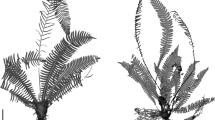Summary
With a view to study their morphology, shape and surface markings, urediospores of 8 species of rusts were examined in 45 % acetic acid. The shape classes were determined by calculating ratios of polar and equatorial axes of 100 spores and then matching them with those given byErdtman (1954). A guide figure, adapted fromErdtman (1954), has been included here as figure 1. The urediospore shapes in the 8 rusts discussed here preponderated as follows:
Crossopsora zizyphi — prolate or perprolate;Phragmidiella heterophragmae — prolate spheroidal or spheroidal;Puccinia dietelii — prolate, prolate spheroidal or spheroidal;P. operta — prolate;P. purpurea — prolate;Puccinia sp. onAsystasia mysurensis — prolate, prolate spheroidal;Scopella aulica — prolate, prolate spheroidal;S. gentilis — prolate, prolate spheroidal.
It has been found that there exists a narrow achromatic passage in the secondary wall (where present) above the hila of somewhat immature spores. The spore, right upto the time of its shedding, thus seems to have a means of drawing in the cytoplasm, or communicating with, the sorus constituents. In mature spores this opening may be occluded by the development of I- or Y- shaped partitions, wart-like plugs or plano convex thickenings in the secondary wall.
LO-analysis which consists of observing the spore walls at successive adjustments of the microscope, has been conducted on two allied species —Scopella aulica andS. gentilis. It has been suggested that LO-analysis might be useful in the Taxonomic and Morphologic differentiation of species as well as in the study of fungal air spora and fossil spores.
Similar content being viewed by others
References
Buller, A. H. R. (1933) Researches on Fungi, Vol. V, Longmans, Green & Co., London.
Erdtman, G. (1952) Pollen Morphology and Plant Taxonomy, 539 pp., Almqvist & Wiksell, Stockholm.
Erdtman, G. (1954) An Introduction to Pollen Analysis, 239 pp. Chronica Botanica Co., Waltham, Mass., U.S.A.
Erdtman, G. (1956) “LO-analysis” and “Welcker's Rule”, a Cenrenary. Svensk bot. Tidskr.,50 135–141.
Langeron, M. (1952) Précis de Mycologie,703 pp., Paris.
Payak, M. M. (1959) “LO-analysis” as an aid in the study of fungal spore morphology. Nature, Lond.184 738.
Savile, D. B. O. (1954) Cellular mechanics, taxonomy and evolution in the Uredinales and Ustilaginales. Mycologia,46 736–761.
Wahrlich, W. (1893) Zur Anatomie der Zellen bei Pilzen und Fadenalgen. Scripta bot. Horti Univ. Imp. Petropolitanae,4 101–155 (original not seen).
Author information
Authors and Affiliations
Rights and permissions
About this article
Cite this article
Payak, M.M. Spore morphology and “LO-analysis” of spore surface ornamentation in some rust fungi. Mycopathologia et Mycologia Applicata 16, 70–82 (1962). https://doi.org/10.1007/BF02136182
Issue Date:
DOI: https://doi.org/10.1007/BF02136182




